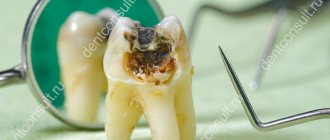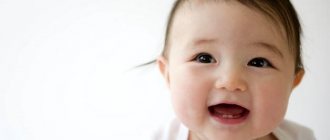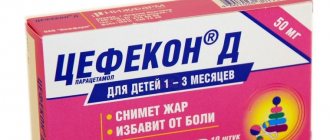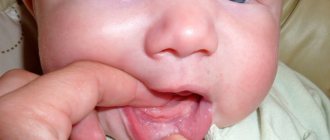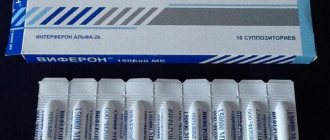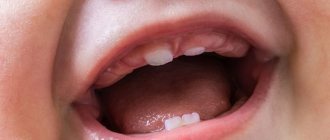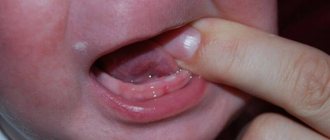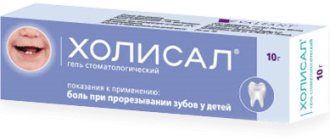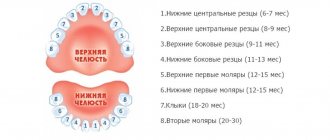Teething is a difficult period for babies and their parents. Every child experiences itching, pain and other unpleasant sensations at this time. And, of course, mom and dad don’t stand aside, trying to facilitate the appearance of the first teeth as much as possible by applying special gels for children’s gums, massage and other activities.
Let's figure out how to determine that your baby has started teething. Let's find out how to reduce discomfort.
How to make teething easier for children.
December 15, 2022
2615
5
2
Content
- Symptoms of teething in children
- Top 7 pain-relieving gels for teething
- Kamistad Baby
- Dentinale
- Holisal
- Baby Doctor First teeth
- Kalgel
- Pansoral
- Dentinox
A baby’s first teeth are always a great joy for parents, but often this is accompanied by a deterioration in the child’s well-being, fever, moodiness and bad mood. Only 30% of young children do not have any negative symptoms when teething. In pharmacies you can buy various drugs to improve the condition of a child during teething: both drugs for oral administration and for external use. Today we’ll talk about gels for gums.
Many parents buy such products on the advice of friends or based on reviews from moms on forums. But it is better to consult a pediatrician before purchasing a painkiller, because only a doctor can take into account all the individual characteristics of your baby’s body and choose a truly effective and safe remedy.
Read also Top 10 best hypoallergenic formulas for children 10 best infant formulas for children with allergies.
The effectiveness of baby gels for gums, how to use them when teething
Before buying this or that gel, consult your doctor to be sure of the safety and effectiveness of the product. Be sure to read the instructions before first use.
Basic rules for using gum gel when teething in a child:
- Apply the gel using a sterile cotton swab or very carefully with clean fingers.
- The product must be rubbed in slowly in a circular motion.
- Remember that a very small amount of gel is enough. Do not overdo it.
- The product can be used no more than four to five times a day, with a minimum interval of four hours between applications.
- Gels should only be used in cases of severe pain or discomfort. Usually the most painful teeth are the first two incisors and those that appear in the second year of life.
Symptoms of teething in children
Typically, when teething, the following symptoms are observed:
- excessive salivation, which can cause the baby to cough, possible hoarseness, a rash around the mouth and on the chin;
- soreness and swelling of the gums;
- itching of the gums (the child puts various objects in his mouth to “scratch” the gums);
- deterioration of appetite or its complete absence;
- increased body temperature;
- sleep problems;
- increased excitability, tearfulness;
- runny nose;
- stool disorder.
It is important to note that not all children have all the symptoms on this list. These may be several symptoms of teething, or even none at all. Everything is very individual.
How children cut teeth
Kamistad Baby
This German gel contains two main components: chamomile (disinfects, soothes and relieves inflammation) and polidocanol (a local anesthetic that is as safe as possible for the child’s body). “Kamistad Baby” has a sweetish-honey taste, so the baby will definitely not spit it out. The product is packaged in a convenient tube with a thin dispenser spout, so the gel is easy to apply to children's gums. Literally immediately after application, the drug begins to work, relieving pain, and the effect lasts for several hours. In addition to teething in babies, Kamistad Baby is prescribed for stomatitis and gingivitis in adults, for healing erosions in the oral cavity, after surgical procedures.
Kamistad Baby
STADA CIS, Russia
Kamistad® Baby is recommended at the first signs of teething in children.
from 273
269
- Like
- Write a review
Dental treatment with gel
Treatment of caries with gel
Professional gels and toothpastes for caries
When a person eats a lot of sweet and sour foods and does not maintain oral hygiene, bacteria begin to destroy tooth enamel. Caries appears. It is treated using a drill: the doctor drills out the carious cavity, removes decay products and fills the tooth. That's how it was until today. They say that caries can now be cured with the help of special gels and toothpastes. Is this true or a myth? Let’s find out in this article.
Dentinale
This teething gel helps babies get through the difficult period easier. Dentinale contains only safe ingredients, no chemical painkillers. The drug contains chamomile extract, aloe vera juice and boswellia. Dentinale reduces gum sensitivity, relieves inflammation and provides excellent pain relief. After applying the gel, a protective film is formed on the gums, so the child calms down and falls asleep. The drug can be applied many times, and the effect lasts for several hours. Dentinale does not contain sugar, parabens, or lidocaine. The gel has a sweetish, pleasant taste that your baby will definitely like. Dentinale can be used even by children prone to allergies.
Holisal
This Polish gel has a wide range of dental indications. It is suitable for both adults and children. You can use "Cholisal" when teething in babies from 6 months of age. The active ingredient of the drug is choline salicylate. The product has antimicrobial, anti-inflammatory, soothing and analgesic effects. “Cholisal” instantly relieves gum irritation and also reduces their bleeding (which is important for various oral problems in adults). The drug is sold in a convenient small tube; it should be used with caution in children under one year of age. The downside is the high cost.
Holisal
Pharmaceutical plant Elfa A.O., Poland
For local use on the mucous membranes of the oral cavity as an analgesic and anti-inflammatory agent in the treatment of periodontal diseases, damage to the mucous membrane, diseases that occur with an inflammatory reaction and pain: - stomatitis of various etiologies;
- gingivitis; - periodontitis; - damage to the oral mucosa when wearing dentures; - trauma to the oral mucosa; - pain during teething in children; - cheilitis; — candidiasis of the oral mucosa; — minor surgical interventions in the oral cavity; - lichen planus when localized on the oral mucosa; — damage to the oral mucosa in Stevens-Johnson syndrome (as part of complex therapy). from 204
5.0 6 reviews
1271
- Like
- Write a review
Experts choose
The problem of choosing a drug for rapid healing and pain relief from damage to the oral mucosa is very relevant, both for adults and young patients, doctors and pharmacists. But why?
Many of these products require repeated use because they are quickly washed off with saliva, which is not very convenient to use. Meanwhile, in order to ensure regeneration, the drug must remain in the oral cavity for a long time without losing its effectiveness. What is the choice of specialists?
At first glance, it may seem that it is mainly children who suffer from stomatitis: learning the world by heart, they put foreign objects into their mouths, which, as a rule, are not very clean and can damage the oral mucosa. However, the microflora of the child’s oral cavity resists infection much more strongly. Therefore, stomatitis is a problem faced not only by children, but also by adults.
Common causes of stomatitis include lack of vitamins, decreased immunity, diseases of the digestive, cardiovascular and endocrine systems. Stomatitis can appear due to connective tissue diseases, viral infections, or be of an allergic nature. Local causes of stomatitis are often associated with some traumatic factor. For example, during the period of getting used to orthopedic prostheses, bedsores may appear. Or correcting a bite using a brace system often results in injury to the inner surface of the lips. Damage to the oral mucosa is possible after surgical interventions, implantation, professional hygienic cleanings, consumption of hot foods and drinks, etc.
Dentists also “cry”
Among professionals, stomatitis is considered one of the most difficult pathologies. First, saliva makes it difficult to maintain dryness. Secondly, it is impossible to isolate the oral cavity from various irritants by prohibiting the patient from eating. An effective regenerating agent must remain on the mucous membrane for a sufficient time, relieve pain and accelerate the healing process. Therefore, professionals prefer Solcoseryl® dental adhesive paste.
Solcoseryl® dental adhesive paste is designed specifically for rapid healing and pain relief of mucosal injuries. It took into account all the anatomical and physiological features of the oral mucosa. Solcoseryl® improves microcirculation, reduces swelling, shortens healing time and restores the mucous membrane. In addition, the dental adhesive paste contains the anesthetic polidocanol, which begins to act within 1-5 minutes after application and relieves pain within 3-5 hours. This is very important, given that any, even the most minor, damage to the oral mucosa is very painful.
Resilience is the key to recovery
Solcoseryl® dental adhesive paste is resistant to being washed off by saliva and forms a protective film that can remain on the surface of the wound for 2-5 hours. All this time, the paste protects the mucous membrane from irritants, and its active ingredients absorb discharge from the wound and promote a rapid healing process.
Does not contain antiseptics, hormones and sugar, which minimizes the risk of unwanted reactions and allows the paste to be used by patients with concomitant diseases.
At the reception and at home
Adhesive paste is used not only in the dentist's office - it can also be used at home. The paste is available in 5 g tubes - this is usually enough for the full course of treatment. A 0.5 cm strip of paste is applied to the previously dried area of the mucous membrane and slightly moistened with water.
What are the advantages of Solcoseryl® paste compared to other oral products?
SDAP is a universal dental paste that can be used in all cases associated with violations of the integrity of the oral mucosa. This is its main advantage. In addition, Solcoseryl® paste does not contain the antiseptic chlorhexidine, which makes it possible to use it for a long time, has a quick and long-lasting local analgesic effect, adsorbs discharge from the wound well, creates conditions for the fastest tissue regeneration, and has a cytoprotective and membrane-stabilizing effect.
What exactly is your recommendation for Solcoseryl® dental adhesive paste based on?
I recommend drugs based on data on their effectiveness, safety, and also take into account customer reviews. Dental adhesive paste Solcoseryl can be recommended for many indications - it is convenient. Solcoseryl®, unlike other oral products, adheres well to the mucous membrane and allows food intake, which patients really like. I keep some statistics on reviews, and everyone who used the adhesive paste was satisfied.
To which groups of patients and in what cases can Solcoseryl® dental adhesive paste be used?
To protect mucosal damage, relieve pain, and promote rapid healing, Solcoseryl® can be used by almost all age groups of patients. For diseases such as gingivitis, periodontitis, conditions after surgical interventions, installation of implants, removal of dental plaque, trauma to the mucous membrane during the period of adaptation to orthopedic and orthodontic structures. In addition, dental adhesive paste is also effective for damage to the mucous membrane caused by general diseases of the body. The paste can be used by children with stomatitis, as well as by pregnant women and nursing mothers - the drug is quite safe.
So, the choice of specialists is obvious - for professionals, Solcoseryl® dental adhesive paste is the means of choice in the treatment of inflammatory diseases and damage to the oral mucosa.
Source: Pharmacy Council Magazine
Baby Doctor First teeth
This Israeli teething gel contains plantain, marshmallow root, chamomile, calendula, and echinacea. This is an ideal drug for both infants and older children. “Baby Doctor First Teeth” quickly relieves inflammation of the gums, the drug is completely natural and hypoallergenic. The gel contains no anesthetics, so it is suitable for children. The product provides long-term relief from pain, itching and inflammation. It is also important that you can use “Baby Doctor First Teeth” as much as necessary per day. Many pediatricians and parents speak only positively about the drug.
Baby Doctor First teeth
Baby Doctor gel for gums First teeth is a transparent pinkish gel, tasteless and odorless.
The gel instantly soothes the gums and eliminates inflammation. With regular use of the gel, the teething period of an infant is greatly facilitated and the occurrence of complications is eliminated. from 279
5.0 1 review
46
- Like
- Write a review
Teething by age
Gum massage during teething
Since drug treatment cannot be considered completely safe, you should try more moderate options first. We have already talked about one of them above - these are teethers. In addition to these, other measures can be taken. For example, switch to chilled food and drink. This will help reduce the discomfort a little.
Gentle gum massage will also be an effective solution. Be very careful, since your baby's gums are very delicate, if you overdo it, there is a risk of increasing the pain. Therefore, you should approach massage wisely and with balance. And most importantly, with full knowledge of the methodology.
The massage consists of three main stages:
- Preparation.
If you decide that you will massage your gums with your finger, you need to trim your nails well, rinse thoroughly, and disinfect. It is very important to get rid of any dirt on your hand. But since this is quite difficult, there is a simpler and more convenient option - use special finger pads or napkins. They can not only massage your gums, but also gently clean your first teeth of food debris. Wet wipes "ASEPTA BABY" from 0 to 3 years help reduce pain during teething, effectively cleanse the oral cavity of food debris, and reduce the risk of inflammation. Each napkin is individually packaged; when using, you do not need to rinse your mouth with water. So you can have a massage not only at home, if necessary. Place the napkin on your finger, now you can proceed directly to the massage itself. - Massage.
Both infants and older children need to move massage movements from the edges of the disturbing areas to the site of eruption. Lightly rub the gums, stroke or apply a little pressure. All these movements can be combined. Watch your baby's reaction and choose the option he likes best. You don’t have to worry that you won’t be able to reach all the places; the soft fibers of the finger napkin will help you massage hard-to-reach areas. Remember that the procedure should be carried out only where the roots of the teeth are. There is no need to massage the eruption site itself, as this can worsen the child’s condition, cause discomfort and make it difficult for the tooth to emerge. - Hygiene.
As early as six months, you can accustom your child to the need for daily oral care. At this time, it is already recommended to use a special children's brush instead of a finger napkin, as well as toothpastes intended for children. For example, ASEPTA BABY paste, made on the basis of plant extracts. This product does not contain resin or abrasive substances, so it is excellent for newly erupted baby teeth that are still fragile. The paste has a pleasant taste, which will make the cleaning process more enjoyable. At first, watch the cleaning, and when the child grows up, he can do everything on his own.
Teething massage is an effective procedure that can not only reduce discomfort, but also reduce the use of medications. But it is very important to be extremely careful when performing a massage, both for infants and older children. Babies' gums are much more tender than those of adults. But if you do everything correctly, then after a fairly short time you will notice that the baby has become more comfortable, he has calmed down, and the teething itself is faster and easier.
Kalgel
You can buy "Kalgel" only with a doctor's prescription, since this drug contains a powerful anesthetic - lidocaine, and it should be used with caution in small children, an overdose is dangerous. "Kalgel" is prescribed in difficult cases of teething in children, when weaker drugs do not have an effect. The gel also contains cetylpyridinium chloride - it disinfects and relieves inflammation due to bacterial infection. Kalgel has a powerful and long-lasting effect, but it is very important to observe the frequency of use and dosage.
Kalgel
GlaxoSmithKline, France
- for quick relief of pain during teething and reduce the severity of gum irritation.
The drug Kalgel also has a weak antiseptic effect. from 260
519
- Like
- Write a review
Pansoral
This is a French phytogel for children's gums, the quality and safety of which are confirmed by international certificates. "Pansoral" relieves inflammation and slightly numbs the baby's gums. Thanks to the rapid penetration of active substances into the mucous membrane, the pain subsides in just two minutes. The preparation contains chamomile and saffron flowers, an extract from marshmallow roots. These components are excellent antiseptics; they heal and disinfect well. Gel "Pansoral" can be used in children from 3 months of age, it is completely natural. The drug is also indicated for the healing of ulcers on the mucous membrane, stomatitis, and bacterial rashes in the oral cavity. It is advisable to consult a pediatrician before using the drug. Among the disadvantages of the product is that it is not available in all pharmacies, it can cause an allergic reaction.
Pansoral
Pierre Fabre Medicament, France
Pansoral is a natural herbal remedy that is used to ease teething in children.
The plant extracts included in the preparation have a calming and softening effect on the gum mucosa. The plant extracts included in the preparation have a calming and softening effect on the mucous membrane of the gums and help the child endure this period easier. from 280
416
- Like
- Write a review
Professional gels and toothpastes for caries
Restores damaged areas of enamel and reduces tooth sensitivity. Recommended for erosion of tooth enamel, exposed tooth neck, after removal of orthodontic structures, before the whitening procedure.
It contains fluorides, which promote mineralization of tooth enamel and help prevent caries.
Promotes tissue regeneration, accelerates wound healing. Has anti-inflammatory, antioxidant, immunostimulating effects.
Indicated for multiple caries, non-carious lesions (fluorosis, hypoplasia, wedge-shaped effect), pathological abrasion of teeth, pregnancy, orthodontic treatment.
The bioavailable calcium and phosphorus included in the composition revive the enamel. Useful minerals reduce sensitivity and strengthen teeth, and milk protein stops tooth decay. Used as a means of caries prevention. The mousse is applied twice a day after brushing your teeth.
Dentinox
This German gel contains chamomile flowers and lidocaine. This drug should be prescribed exclusively by a pediatrician, given the presence of a strong anesthetic in the composition. Dentinox effectively relieves inflammation and pain during teething in babies. The drug is indicated for children from 4 months of age if weaker drugs do not help reduce inflammation and pain. Among the disadvantages of Dentinox are the risks of allergic reactions, fructose in the composition and a contraindication for use in case of damage to the oral mucosa.
Dentinox
Dentinox, Germany
It is used to prevent and relieve pain and inflammation during the eruption of milk and permanent teeth.
from 276
4.0 1 review
406
- Like
- Write a review
